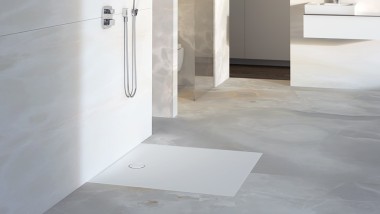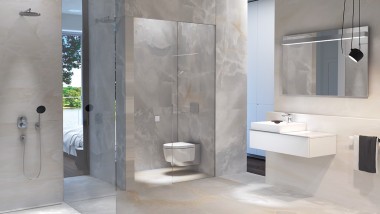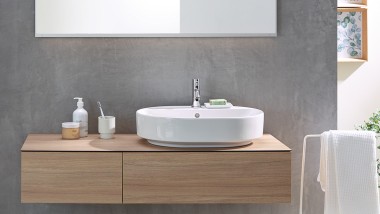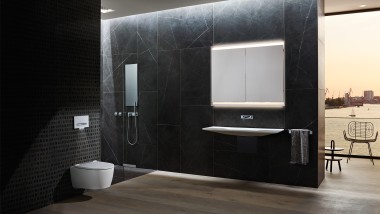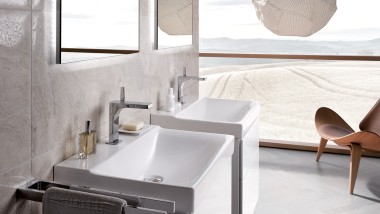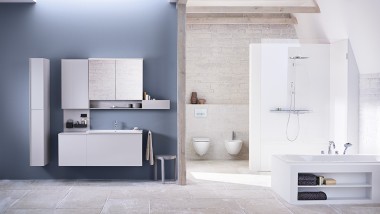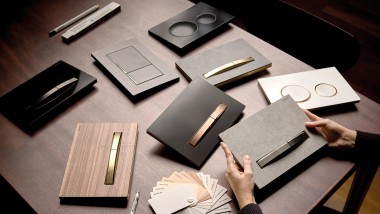Adding accents to your bathroom with wood
For a long time, wood was dismissed as being unsuitable for the bathroom. The general opinion was that mould would quickly pose a problem. This is surprising, given that wood has long been prized as a building material and has been put to use in shipbuilding and window construction – areas in which contact with water is unavoidable. Solid wood furniture has also historically been commonplace in kitchens, where there is a great deal of steam and splatters.
Gradually, we are seeing a paradigm shift when it comes to wood in bathrooms. You can find real wood on the floor, as wall panels, and in bathroom furniture, while lay-on washbasins are increasingly being mounted on fine pieces of solid wood. You can now even get wooden bathtubs and washbasins.
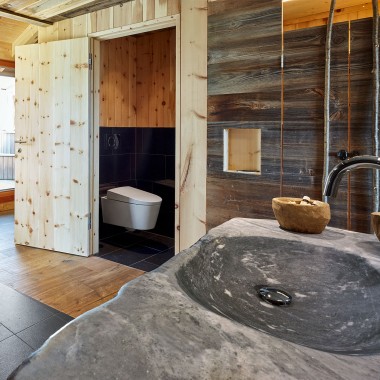
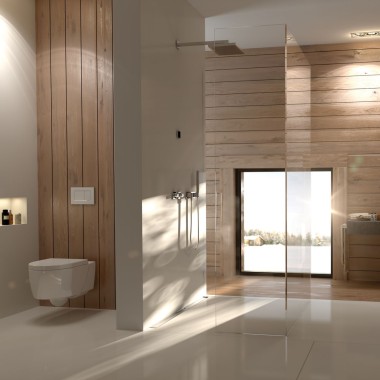
It’s a fact: wood is good for the climate of a room
Wood is alive – which means that it is a characteristic of wood to absorb moisture and release it again. This has a positive and health-enhancing effect on the climate of a room. In addition, some types of wood are known for their antibacterial properties which result from their high acid content. In the bathroom, where hygiene is important, this is a pretty good quality to have.
What to bear in mind if you want to use wood in your bathroom
- Untreated wood has no place in the bathroom. All woods should be treated with oils, varnishes or paints to prevent moisture from penetrating them. That also applies to grooves and tongues in flooring elements and wooden profiles.
- The choice of wood is also important. Hard, heavy woods that are particularly resistant to moisture are the ones to use. It is best to get advice on this from an expert before making a purchase. Some possible wood options include walnut, wenge, spruce and larch, among others.
- Floors must always be completely waterproofed. It is also important to seal the edge joints with jointing compound.
- Timber cladding on the walls should always be rear-ventilated.
Insider tips
- It is advisable to avoid using pine wood in areas exposed to splashes, since pine tends to develop blue stain fungi following extended contact with moisture.
- Oak is not always ideal either. Although this wood is very hard, it tends to stain quickly when cleaning agents are used on it.
- It’s better to steer clear of red woods such as merbau and jatoba in the bathroom, since these also develop unattractive tinges when exposed to moisture.
- By the way, there’s no need to protect your bathroom wood with antifungal or insecticide chemical agents, provided you follow the guidelines described here.
Simple guidelines for care
- Ideally, any splash water in the bathroom should be wiped up immediately so that the water drops cannot penetrate the wood to begin with.
- Be careful not to allow any corrosive cleaning agents to come into contact with the wood.
- Moisture should never be allowed to penetrate into the wood. If you use oiled wood, apply a wood care oil regularly. This will ensure that the wood does not swell and remains sealed. It will also be dirt-repellent.
- Another rule of thumb for the bathroom is that ventilation is essential.
- Wiping wood surfaces with a damp cloth is usually sufficient to clean them.
Newsletter Register now
Stay up to date
Our newsletter provides fascinating insights and handy tips on how your bathroom can make your life easier.

